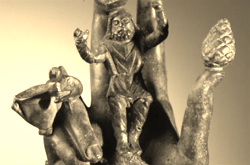Sabazios, Wolny i Nieuchwytny Ojciec Tracji

źródło: http://www.sabazius.com/about-sabazios.html
Yet, their influence on the Greek and Roman world was profound, which none can argue, even if what those specific influences were are still hotly debated. Sabazios, whose various syncretisms will be addressed and explored elsewhere, is a god whose name most likely draws from related terms meaning freedom, and fluidity. He is described at one point in modern scholarship as „the most changeable of gods”, and again, „as the god of no mythology”. I refer to Him as the „Unstoried One”, for indeed, the documented stories pertaining to Him directly are few and far between, despite his rampant worship and undeniable — if at times controversial — presence throughout the many nations of the ancient world.
In short, Sabazios is a Solar-Chthonic nomadic Thracian mountain warrior horseman god of ecstasy, oracle and nocturnal thunderstorms, associated with all manner of mystical, totemic, and esoteric symbols, tools, and practices. Among His most prominent associations is the serpent, a spear or thyrsus-staff and His primary sacrificial animal, which seems to shift geo-culturally between the horned ram and the bull. He is more closely linked to beer than wine, but it seems that any liquid intoxicant would suit Him and His cult just fine. In the ancient world, through interpretatio romana and interpretatio graeca Sabazios was syncretized very heavily with Jupiter/Jove/Iovis, Zeus, and Dionysos-Bacchus.
A note on spelling: Sabazios’ name is inscribed and rendered by various ancient authors in a number of ways (Sabadios; Sauazios; Saazios; Sabos; Sebazios; Sabadius; Sebadius; Sabasiua; Se’beziu; Sabadiua; Sebadi; Sebadas; Sabazis; Sabasius; Sebesius; Sabadius, etc) and, despite the demonstrated variance of these forms, it is accepted that all of these names refer to a single god. Contemporary spellings — „Sabazios” and „Sabazius” — are drawn from the most frequently occurring renderings, which geographically and chronologically support a brief divide in the deity’s cultural identity. The first version, „-zios” is commonly used to refer to older, Thracian understandings of the deity, and is likely closer to how His earliest worshippers spoke the name. The second version „-zius” is a later rendering, frequently considered the Roman variation. While both are acceptable and more or less interchangeable, I have a personal preference for the older „-zios” form, and He doesn’t seem to mind between them.
Jednak, o co nikt nie może się spierać, ich wpływ na grecki i rzymski świat był głęboki, nawet jeśli konkretne wpływy są nadal przedmiotem gorącej debaty. Sabazios, którego różne synkretyzmy zostaną opisane i zbadane w innym miejscu, jest bogiem, którego imię najprawdopodobniej pochodzi od powiązanych terminów, oznaczających wolność i płynność. Został on opisany w pewnym momencie we współczesnej nauce jako „najbardziej zmienny z bogów”, a następnie „jako bóg bez mitologii”. Odnoszę się do Niego jako do „Nieopisanego”, bo rzeczywiście udokumentowane historie odnoszące się do Niego bezpośrednio są bardzo nieliczne, pomimo jego wybujałego kultu i niezaprzeczalnej – jeśli czasami kontrowersyjnej – obecności w wielu narodach starożytnego świata.
Krótko mówiąc, Sabazios to solarno-chtoniczny, tracki, górski wojownik, bóg ekstazy, wyrocznia i nocnej burzy, związany z wszelkimi mistycznymi, totemicznymi i ezoterycznymi symbolami, narzędziami i praktykami. Pośród Jego najsłynniejszych atrybutów jest wąż, włócznia lub laska, tyrs i reprezentujące Go pierwotne zwierzę ofiarne, które wydaje się oscylować geo-kulturowo między rogatym baranem a bykiem. Jest on ściślej związany z piwem niż z winem, ale wydaje się, że każdy płynny środek odurzający pasowałby do niego i do jego kultu. W starożytnym świecie, poprzez interpretatio romana i interpretatio graeca Sabaziosa, bardzo mocno łączono z Jowiszem / Jovem/ Iovisem, Zeusem i Dionizosem-Bachusem.
